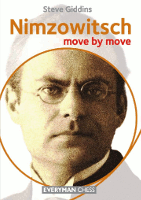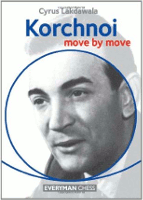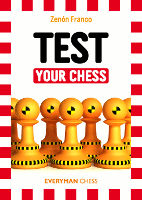Crafty Old Nimzo
Review by Chris Wainscott
Nimzowitsch: Move by Move, by Steve Giddins, Everyman Chess 2014, Paperback, 280pp. $29.95 (ChessCafe Price $25.66); Ebook $19.95
The credit for the title of this review belongs to legendary WGM Camila Baginskaite who referred to Nimzowitsch by this moniker during a lecture at Ole Chess earlier this year.
This installment of the now wildly popular Move by Move series published by Everyman Chess is one of the latest in a growing line of books to feature a specific player. I own all of the previous player-based installments with the exception of Petrosian: Move by Move, so I had a pretty good idea of what to expect as far as the production of the book itself. However, as to the content I was less sure.
I’ll be the first to admit that my knowledge of Aron Nimzowitsch was limited to the fact that he was a hypermodern who pioneered the Nimzo-Indian and wrote My System along with knowing that he was blessed with amazing prophylactic thinking. I didn’t even know until just now that his name was spelled Aron and not Aaron.
I have been asked repeatedly by many players over the year if I have read My System and each time have had to confess that I have not. I was especially intrigued by the fact that not only did WGM Baginskaite refer to the seminal work on positional chess, but that Grandmasters Yermolinsky and Kaidanov did the same a number of times at Ole Chess.
So it was with great interest that I sat down to review this work. I also own The English: Move by Move, which is also by Giddins, and so had respect for his writing and teaching style going in. With all that said, I wasn’t sure what to expect about the games themselves.
I received this book just a day or two after having my gall bladder removed, so I was looking forward to spending some of my recovery time intensely studying this book. When the book arrived I opened to the first page and started in on the content: I didn’t emerge until roughly ten hours and 122 pages had passed. The very definition of a page turner!
The content is divided into five chapters:
- Nimzowitsch the Attacker
- Nimzowitsch the Defender
- Nimzowitsch the Blockader
- Nimzowitsch the Strategist
- Nimzowitsch in the Endgame
While the first two chapters are fairly standard in the player-based segment of the MBM series, it’s the third chapter on blockading that truly makes this book shine, since it’s an amazing illustration of the prophylactic play that Nimzowitch was known for.
Let’s take a look at a position from a well-known game of Nimzowitsch’s (and in fact this is the game that WGM Baginskaite covered in her lecture). The game is Johner-Nimzowitsch from Dresden 1926. The position is just after Black’s 12…Qd7.
![[FEN “r1b2rk1/p2q1ppp/1pnp1n2/2p5/2PPpP2/1NP1P3/P3B1PP/R1BQ1RK1 w - - 0 13”]](https://chesscafe.com/wp-content/uploads/2014/11/review963a.gif)
[FEN “r1b2rk1/p2q1ppp/1pnp1n2/2p5/2PPpP2/1NP1P3/P3B1PP/R1BQ1RK1 w – – 0 13”]
Probably the most famous move of the game, and one of the most famous in all of Nimzowitsch’s entire tournament practice.
Question: What is the idea? It looks a bit peculiar!
Answer: It is another of those deep and rather convoluted strategic ideas, of which Nimzowitsch was so fond, and all tied up with the concepts of prophylaxis and the blockade. His reasoning was as follows: Black has the advantage on the queenside, thanks to the doubled White c-pawns. Given a free hand, he will play …Ba6 and gradually lay siege to the c4 pawn. However, before doing so, he must attend to White’s counterplay. On the kingside, White has what Nimzowitsch called a “qualitative majority”, i.e. not an actual numerical majority of pawns, but a superior pawn position, thanks to the advanced f4 pawn. Basically, White wants to advance on the kingside with g4 and develop an attack on that flank. Black’s basic task, therefore, is to counter this plan.
Question: Aha, I see. So 12…Qd7 just stops 13.g4. But surely White can prepare the advance with 13.h3 can’t he?
Answer: Yes, but Nimzowitsch’s plan goes deeper than just stopping g4 for one move.
The best way to understand Nimzowitsch’s choice of 12…Qd7 is from his note on the alternative, which was the straightforward 12…Ne8. Now he gives the line 13.g4 f5 14.d5 Ne7 15.g5
![[FEN ”r1bqnrk1/p3n1pp/1p1p4/2pP1pP1/2P1pP2/1NP1P3/P3B2P/R1BQ1RK1 b - - 0 15”]](https://chesscafe.com/wp-content/uploads/2014/11/review963b.gif)
[FEN ”r1bqnrk1/p3n1pp/1p1p4/2pP1pP1/2P1pP2/1NP1P3/P3B2P/R1BQ1RK1 b – – 0 15”]
As we see, the position has become extremely blocked, even petrified. Nimzowitsch makes it clear that this is what he was trying to avoid; he regarded his position as already being so good that he had to avoid anything too drawish.
Question: But is that really the case?
Answer: Probably not, just as most masters of his day underestimated the drawbacks of such doubled pawn complexes as White has here, so Nimzowitsch in his turn tended to overestimate their weakness, and assumed that Black has the advantage, in many positions where the modern player would not consider him to be more than equal, often not even that. This is probably such as case, with Nimzowitsch already thinking that his opponent will be desperate to block things up and trying to hang on for a draw at the first opportunity.
Indeed, Kasparov suggests that White has no need to play to close the position after 12…Ne8, and should prefer 13.Bd2 f5 14.Be1 ‘followed by h3-g4 and Bh4, with some initiative for White.’
In many ways the above passage is typical of the book. FM Giddins relies primarily on verbal explanations rather than analytical ones. Clearly his focus is to give readers the information on how to develop the tools needed to attempt these same approaches in their own games or analysis sessions rather than searching for the “truth” of the positions with endless reams of variations.
In most cases I would take issue with this approach since I think that variational explorations into the heart of a position lead to a far greater understanding than verbal explanations that can often times be superficial. However, this isn’t most cases; this is a journey into what made Nimzowitsch tick. Much the same as My System is more a work of prose than one of analytical thinking, so is this treatise into how the pioneering giant of positional play approached his games.
Nevertheless, when it is called for FM Giddins will give in-depth analytical proof of what was taking place over the board. Let’s take a look at Nimzowitsch – Spielmann (5th Match Game) 1920. This game is in the fourth chapter, Nimzowitsch the Strategist. Here is the position after Black’s 31…Nxd4?!.
![[FEN “5rk1/pp3pp1/4p3/2RpP2p/1P1n3P/P4N2/2Q1qPP1/6K1 w - - 0 32”]](https://chesscafe.com/wp-content/uploads/2014/11/review963c.gif)
[FEN “5rk1/pp3pp1/4p3/2RpP2p/1P1n3P/P4N2/2Q1qPP1/6K1 w – – 0 32”]
This wins a pawn, but the Black knight loses a lot of time, and White’s endgame advantage increases. Nimzowitsch gives the alternative variation 31…Qa6 32.a4 f6 33.Ra5 (33.a5 is probably stronger) 33…Qb6 34.Qc5 Qd8 (and here 34…Qxc5 is probably essential, although Black is suffering after 35.bxc5) 35.Rxa7 fxe5 36.Nxe5, and now 36…Qxh4? loses outright to 37.Qxf8+! However, the best move is probably 31…Qxc2. Nimzowitsch dismisses the endgame as bad, because of the invasion on c7, but after 32.Rxc2 Re8 33.Rc7 Re7 34.Rc8+ Kh7 Black is still holding, although it is certainly very passive and unpleasant.
Granted, the above isn’t exactly reaching the level of notes contained in Kasparov’s seminal My Great Predecessors series, but the notes are detailed enough to give an exact explanation of what was happening, rather than just trying to give verbal explanations regarding the game.
Lastly, let’s take a look at a position from Nimzowitsch – Rubinstein 1928 after Black’s 24…Bxe4?!:
![[FEN “r3r1k1/1pq1bpp1/2p4p/p3P3/P2BbP2/1P6/2P1Q2P/3R1R1K w - - 0 25”]](https://chesscafe.com/wp-content/uploads/2014/11/review963d.gif)
[FEN “r3r1k1/1pq1bpp1/2p4p/p3P3/P2BbP2/1P6/2P1Q2P/3R1R1K w – – 0 25”]
Nimzowitsch himself does not criticize this move, but 24…Qc8 was better. Nimzowitsch claimed this was met simply by 25.Qd3, apparently forcing the exchange on 34 anyways, but the computer points out the typically awkward tactical line 25…Bg4 26.Rd2 Rd8! when the pin on the d-file leaves White no time to push his f pawn.
Instead, 25.Rg1 is probably stronger, when a subsequent Qd3 will anyway force the exchange on e4. Black’s best, according to the computer, is 25…Qe6! 26.Bxf5 (the subtle point of Black’s last is 26.Qd3 Bx34+ 27.Qxe4 f5!, exploiting the pin to establish the blockade on f5 again) 26…Qxf5 27.Qd3 Qxd3 28.Rxd3 Rad8 and White still only has a small edge.
FM Giddins spends most of the book in the same fashion as the above passages demonstrate. While nothing is sacred (as in the last position above when the author corrects Nimzowitch’s analysis with the computer) the mission of the book is to convey to the reader Nimzowitch’s approach rather than to prove which lines of his analysis still hold up and which have been refuted over the years.
In my opinion the objective of this book was achieved in spades. While there are fewer games in this book compared to other titles in the MBM series (there are only 30 games in this book vs. the 50 or 60 in most of the other books), the overall treatment of each game is in-depth and therefore, at least in my eyes, more than makes up for the smaller number of games.
FM Giddins did a reasonable job of making Nimzowitsch more accessible to players like myself who had limited knowledge of the German master.
My assessment of this book:
![]()
Order Nimzowitsch Move by Move
by Steve Giddins
Order Nimzowitsch Move by Move (Ebook)
by Steve Giddins
A PDF file of this week’s review, along with all previous reviews, is available in the ChessCafe.com Archives.
© 2014 ChessEdu.org. All Rights Reserved.




The review’s last sentence calls Nimzowitsch a “German master.” This is incorrect. While the original spelling of his name, Niemzowitsch, means “from Germany,” and he could speak and write in German, he was actually a Latvian Jew born in Riga. Later he moved to Sweden and then Denmark. So neither by birth nor residence could he be considered German.